15 October 2022 – 17 December 2022
Deep Water: Women artists innovating with a variety of media to reflect on sea water pollution and dangers to wildlife and ocean environments.
Mary Blue, Aude Bourgine, Colleen Flanigan, Zena Holloway, Julia Manning, Liz McGowan, Dawn Roe, Phillipa Silcock.
The entire world is in Deep Water in many respects. Because of global warming sea levels are rising. This exhibition deepens our understanding.
There is increasing ocean acidification from pollution.
Marine eco-systems are suffering.
Biodiversity is being lost at sea as well as on land.
Human induced climate change is the main problem.
The latest IPCC Assessment report on climate change tells us that many of the losses in fresh water, as well as in coastal and open ocean marine systems, are already irreversible. Many coral reefs for example, bleached by ocean acidification and warming, have reached their limits and can no longer be healed. Coastal wetlands are under stress as seas rise and salt-water encroaches further into land.
The entire world is in deep water
This exhibition looks at the dangers under deep water. It shows some of the passionate concerns of artists about eco-systems and species which are under stress.
We need to see this work in order to know more and understand better where are the stresses, and how we might act to improve environments.
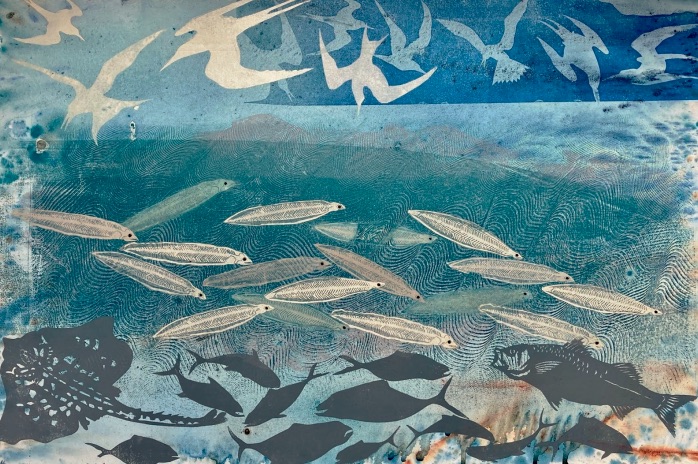
Aiming to heal
Showing their work in Deep Water, are eight artists whose impetus comes from seeing the pain of the oceans – but wanting to heal them. They all have specialist knowledge – of eco-systems, of species and of deep local and indigenous experience.They are drawing attention to the dangers and the degradation – but having an overriding impulse to repair.
All the artists involved in this exhibition are women. It has almost happened by accident – but then maybe not. According to the latest IPCC assessment report on climate change, women are among the traditionally marginalised groups, and under-represented in climate debates. But surely as an equal majority of the world’s population their voices ought be strongly present. Here in this exhibition are works by women who are professional, knowledgeable, and passionately concerned with the issues they represent.
Julia Manning: The plight of the eel:
Julia Manning is a master printmaker, based in Somerset. Collaborating with international eel expert, Andy Don, she has been documenting the plight of eels around her local rivers and coast. Her dramatic print portfolio shows how concerns extend much further.
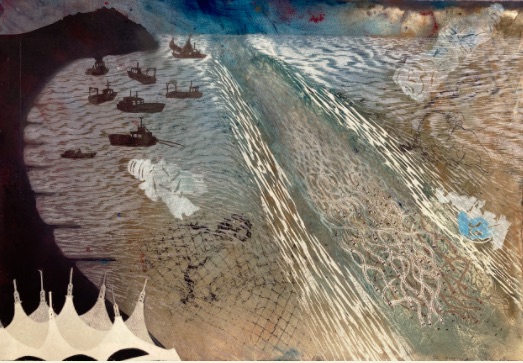
The eel is a migratory species which has suffered dramatically over the last 50 years. The European Eel is classified as critically endangered by the IUCN (International Union for the Conservation of Nature). It is on the Red List because of the alarming statistic that the numbers of juvenile eels entering European rivers has declined by 95% since 1970. Julia Manning’s extraordinary print series about the terrible plight of the eel makes us realise that we are witnessing a species extinction under our very noses. The exhibition will give much more detail about this in due course – how it is not just climate change which is causing eel decline and death . During their migratory journeys eels are killed by pollution, and the power of waters around pumping stations, weirs, nuclear power plants and hydro-power stations.
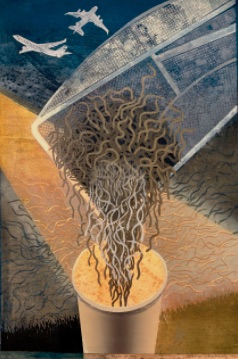
Using high river flows and the tides to their advantage in late October and November, eels are completely single- minded in their quest to reach the Sargasso Sea, near Bermuda, some 3500 miles away where they breed and die.
There is then the hazardous new journey back towards Europe and transformation of eggs into larvae, then leptocephali and then glass eels.
In their 3500 mile journey these juveniles might succumb to rogue currents, starvation, or fall prey to fish and seabirds. The surviving glass eels teem into Bridgwater Bay in February time.
They use tidal flows to get transported into our river systems in the spring, where they then turn into elvers and subsequently yellow eels. They stay in our Somerset freshwaters for many years, up to 25, before feeling the pull of the sea and heading out on their final migration.
Zena Holloway: Coral reef bleaching
The latest IPCC report states that because of global warming and ocean acidification many coral reefs have already reached the limits of their ability to regenerate. In their healthy state they have a symbiotic relationship with algae which feed from them and give them their colour. During extremes of heat which are increasing, the coral expels the algae and gradually dies. The bleaching is a sign. This is an entirely human-induced poisoning of the environment. You can read more about it here.
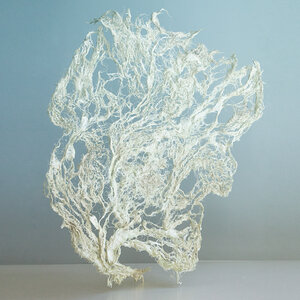
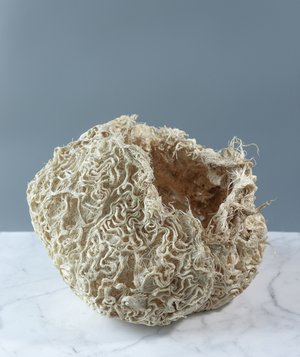
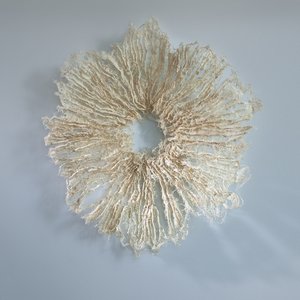
London-based artist and bio-designer Zena Holloway , also a former deep ocean diver and photographer, has direct experience of coral bleaching and is horrified by it. She is using an innovative technique to grow roots in moulds carved from beeswax to form sculpture and wearables. In an extraordinary way they echo the forms of coral, both physically and metaphorically.
As she says in an interview by Priyanka Sacheti for Resurgence magazine, 2022
“Roots are building blocks for the land, while coral is similarly so underwater. It is critical to the health of oceans.”
Zena’s work straddles that of art, design and fashion. Her coral reef dresses enable a wearer to carry these environmental concerns literally about their person in a compelling way. A reference to the hugely polluting fashion industry. Root fashion is about a new attitude to sustainability, a circular economy and growing awareness of materiality.
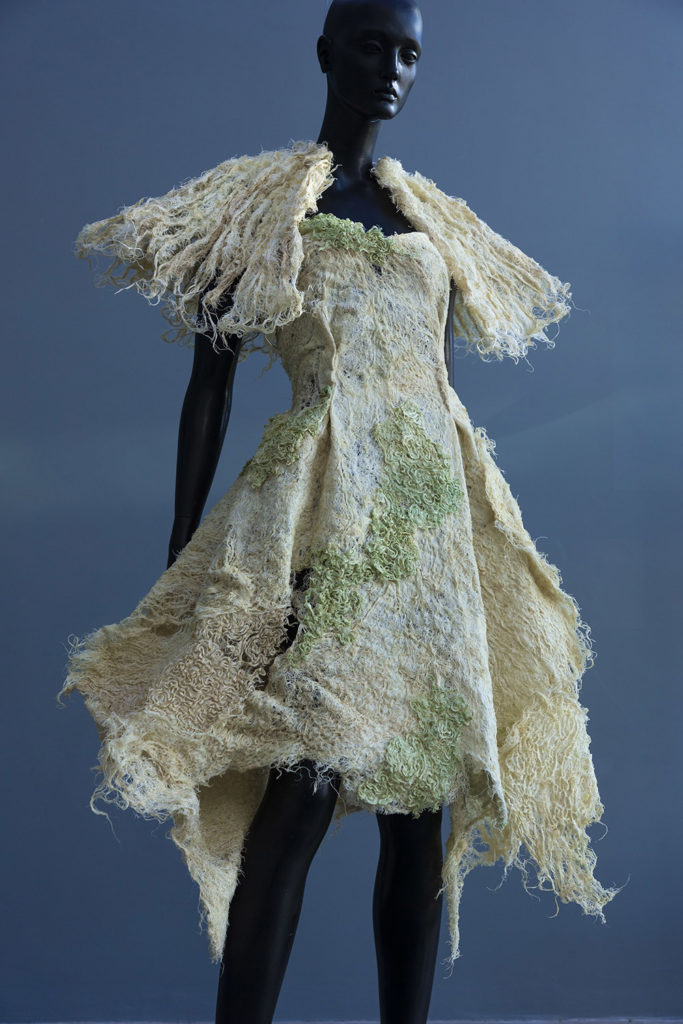
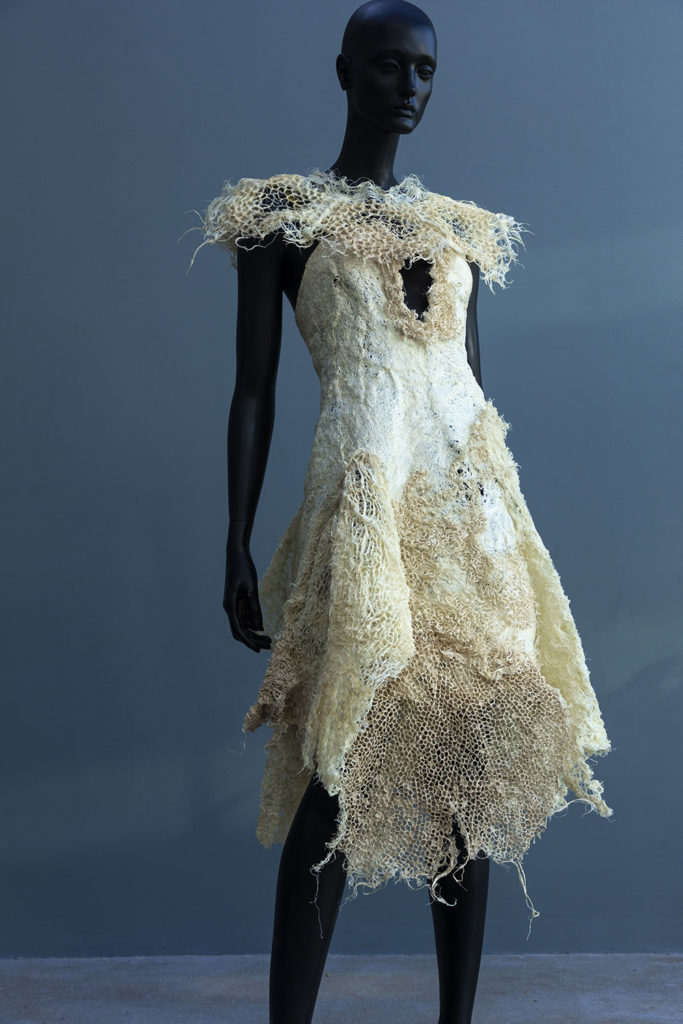
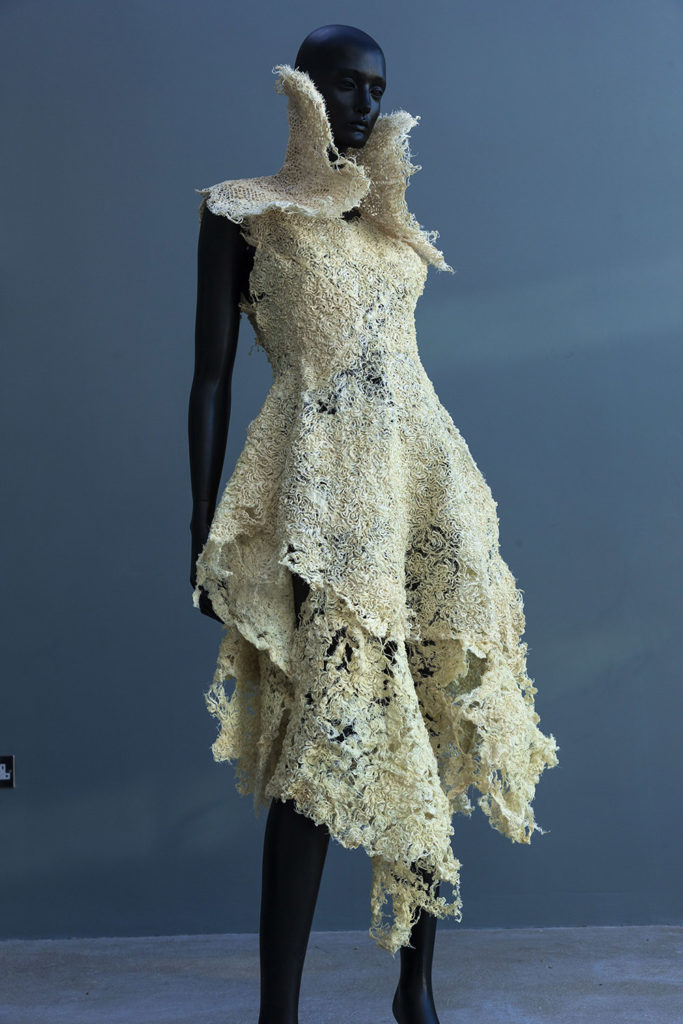
Zena Holloway Reef dresses
Aude Bourgine: Creating poetic coral forms
Equally highlighting the bleaching of coral reefs is Rouen-based artist, Aude Bourgine. She is an artist committed to the environment. Driven by the injustice in the face of major climatic ills, she aims to inspire wonder about the environment and especially the seas.
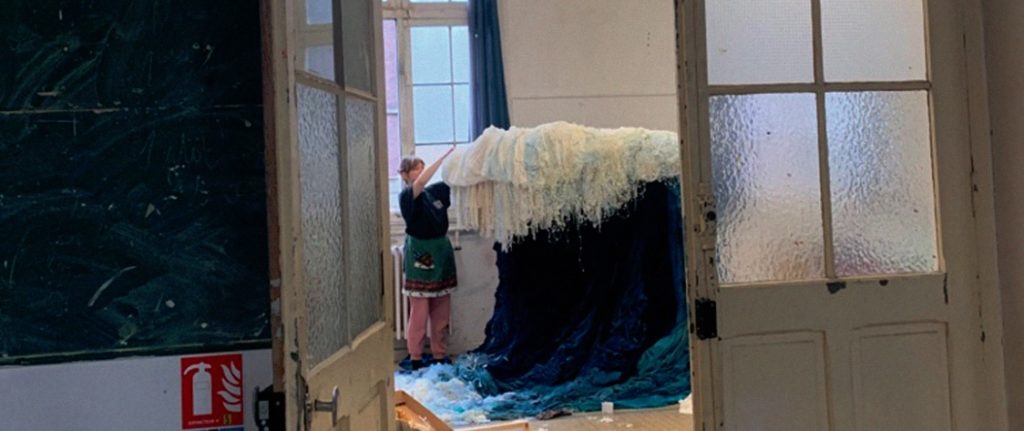
Among her corpus of works are sculptures in which recycled materials predominate. Textiles, due to the variety of their materials, textures and colors, have always been her medium of choice. Her new coral-like forms create dramatic installations. These testify to the ills of coral bleaching, while transmitting a passion for the poetry of the ocean environment.
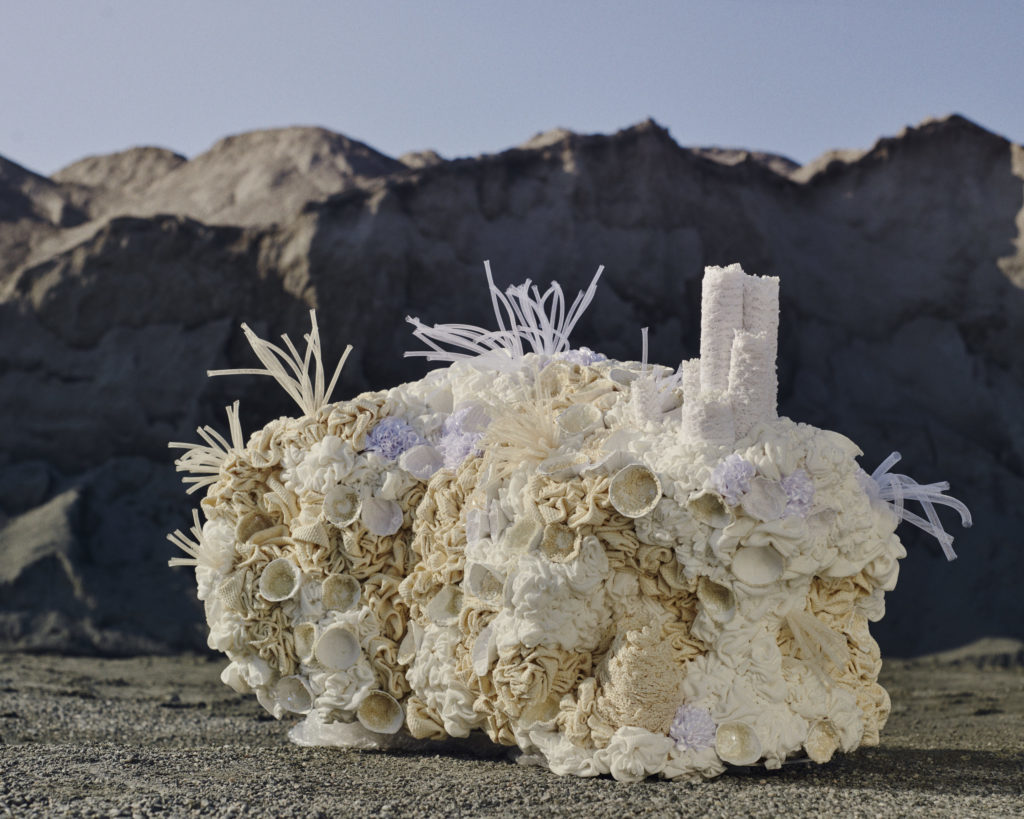
Like Zena’s works, Aude’s sculptures are made on dry land, with soft and dry materials. They show how art can operate both physically and metaphorically, working both on memory and association. For Deep Water they will evoke an imaginative world of coral in a way that is resourceful and clever. But perhaps all the more hard-hitting because of the poetry of their making.
Colleen Flanigan: Shallow reef coral restoration supports deep water ecosystems
Colleen Flanigan is a socio-ecological artist. Her work is inter-disciplinary. Through visual, performing, and biological arts, she investigates contemporary issues of species in danger.
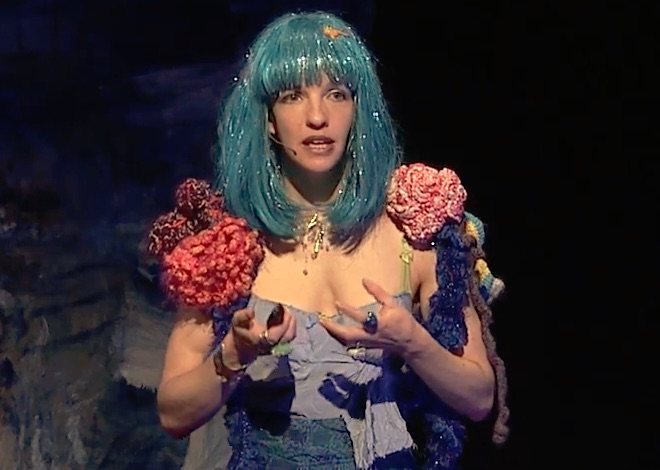
“As more people become aware of the issues of sea level rise, climate change, pollution, and over-fishing, it is our time to explore how to resuscitate our ocean biodiversity and protect our shores with interdisciplinary re-coralization.”
Colleen is developing a holistic innovative approach to ecosystem regeneration; mitigating climate change and its effects is a powerfully motivating incentive. Coral reefs are her prime subject. Using electrolytic mineral accretion technology, she creates Living Sea Sculptures. They inspire interaction, becoming participatory multimedia exhibitions as well as scientific research projects.
About Living Sea Sculpture
Rather than artworks about ecology that solely derive inspiration from nature and the environment, this is actually art as ecology. Low volt DC electricity flowing through seawater raises the pH locally to attract calcium carbonate and magnesium hydroxide minerals, to deposit onto a metal matrix. Corals readily attach to this natural substrate that uses the same minerals they use to build their exoskeletons. They can grow faster and tolerate some environmental stress that normally bleaches or kills them in some cases.
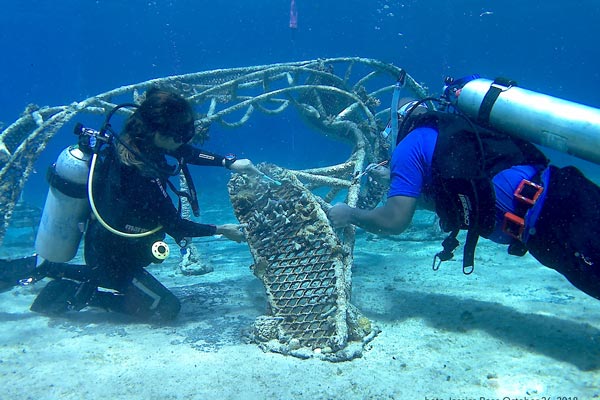
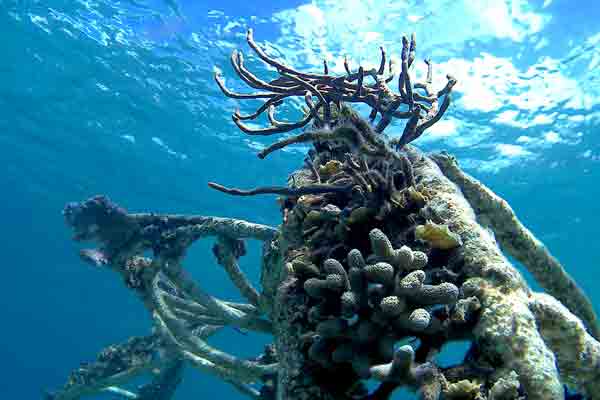
Through this method, the artist is creating mineral accretion reefs as original sea-scaping compositions. These can be any shape or size. Both functional and
artistic, they evolve into large aquatic topiary-like
ecosystems that are vital for shore protection, marine biodiversity, and compatible interspecies relationships. They are ongoing collaborations with the ocean highlighting hope, fragility, life, and death. She is in effect designing relationships with vibrant living plants and animals.
Furthermore, she is widening the scope of the project by joining forces with the United Nations Decade of Ocean Science for Sustainable Development. In June, The Cozumel Coral Conservatory was recognized and endorsed by UNESCO. https://www.oceandecade.org/ actions/the-cozumel-coral-conservatory/
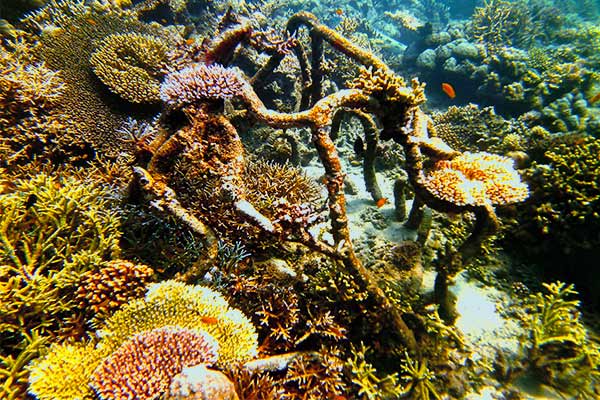
In Deep Water we will see how the artist is creating mineral accretion reefs, as original sea-scaping compositions. These can be any shape or size,. Both functional and artistic, they evolve into large aquatic topiary-like ecosystems. She is in effect designing relationships with vibrant living plants and animals
Furthermore, she is widening the scope of the project to consider relationships with human health.
She describes the process as follows:
I’m developing an interactive, immersive multimedia exhibit correlating coral health with human health through the context of artificial respiration and innovative life support. Kinetic, responsive sculptures interpret data from human participants and the ocean in juxtaposition with video and sound.
Information on climate change in the abstract can be overwhelming for people – it does not automatically inspire empathy or engagement in solutions. People can engage with the whole development of Living Sea Sculpture as it grows. In this way I hope to raise people’s sensitivity to other species and our interdependence.
By translating participant and oceanic numerical data, the project not only quantifies results, but also enables us to see and feel our living connection with corals through our mutually breathing bodies.
https://colleenflanigan.com/lss1.html
Liz McGowan: Coastal wetlands and northern deep water
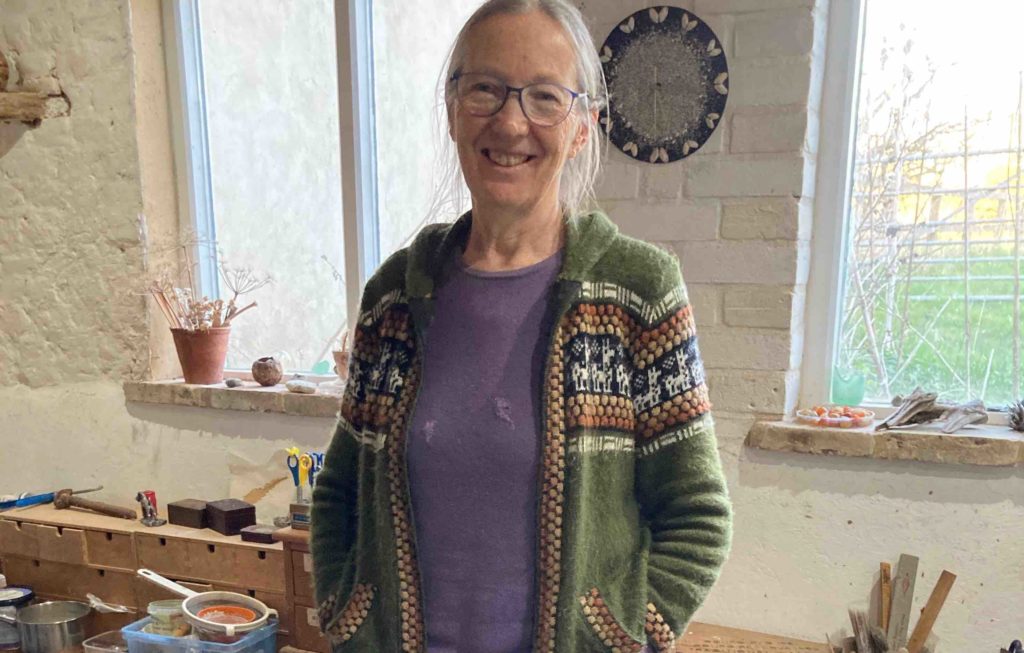
Liz has created a new series of works for Deep Water using elements of the chalk reef landscape that have washed up onto the tideline, combined with soot from her chimney to symbolise the human made pollution that poses a threat to such ecosystems. By placing them together, cheek by jowl, she highlights the direct consequences of our actions upon the beings that surround us.
Here, delicate seaweeds and bryozoa are placed onto chalk from the reef, and shadows or absences are created by sprinkling soot over them.
This sense of them disappearing also reflects the fact that these reefs remain largely hidden by the murkiness of the water. Their vibrant colours and biodiversity only appear on one or two days in the year.
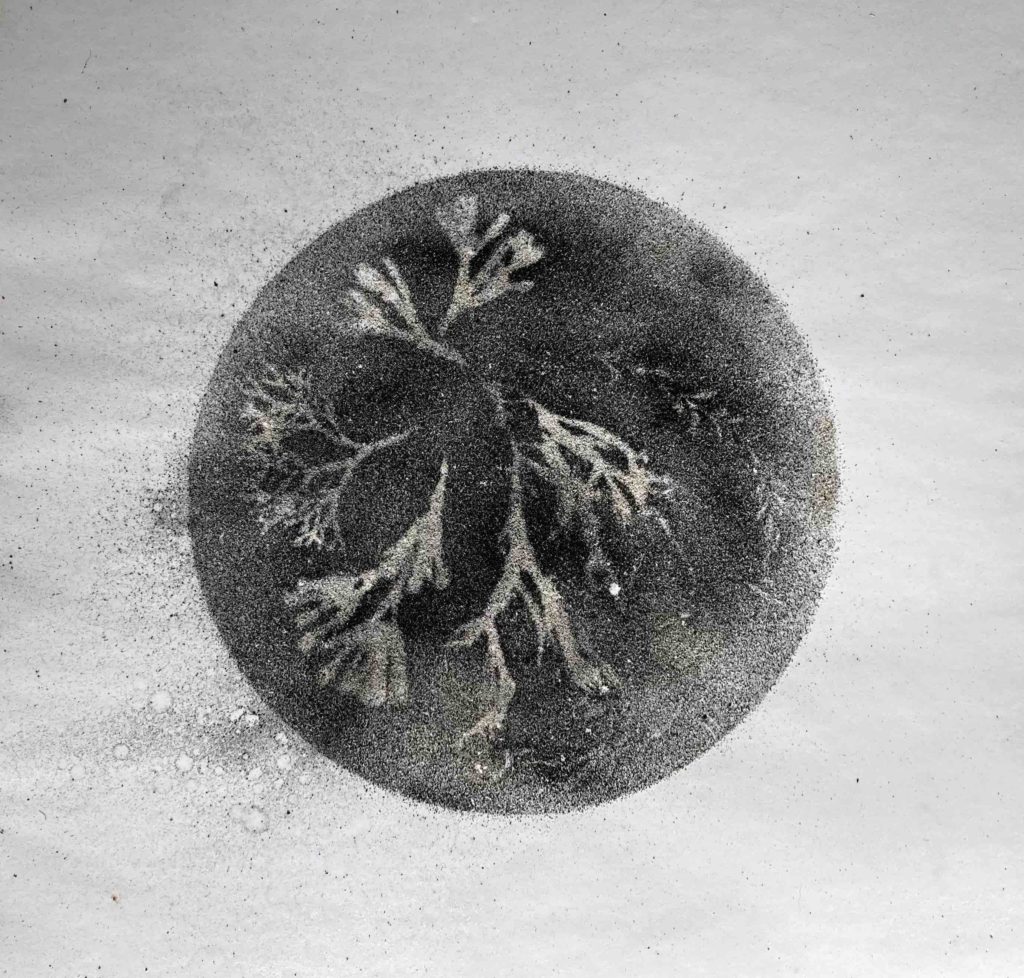
“I work in conversation with the Norfolk landscape, exploring the meeting points between inner and outer landscapes. My inspirations are the detail, pattern and processes – reed, mud, wind, wave, erosion, tideline – that combine to form a particular environment. My personal concerns are about containment and expansion, about cycles of growth, change and decay, and about the shifting relationship between us and the world in which we are immersed.”
Dawn Roe: Human and non-human interactions with deep water
Dawn Roe, based between Florida and North Carolina, was born and raised amidst what are now known as the Great Lakes in the U.S. state of Michigan where she developed a long term interest in land/water relations between human and more than human communities. As a white woman from settler ancestry, Roe’s current work seeks to develop methods of respectful engagement with place that center longstanding Indigenous ethics of care as vital to the past and present health of waterways throughout North America.

She is represented in Deep Water by her work: Descent: An Atlas of Relation
DESCENT ≈ An Atlas of Relation is an installation which considers the entanglement of human and more-than-human lives by looking at how distinct and varied bodies of water enter into conversation with one another. Freshwater rivers and lakes connect to seaways through channels and locks – and land masses. Plant and animal beings rely on these relations to survive. Fish negotiate ecological disturbances throughout their transitory movements in interconnected waters. They are considered as markers of deep time and indicators of evolutionary processes.
Disruptions to this biodiverse ecosystem mirror those of other waters transformed by industry over time, leading to a need for contemporary “species management” that has become irreversibly and paradoxically connected with maintaining healthy fisheries and waters
- DESCENT ≈ An Atlas of Relation draws on the dormant pathos embedded within lands where human and more-than-human lives entangle while observing correspondences between the many resilient beings sharing the planet with one another
- the project looks to the fish as markers of deep time and indicators of evolutionary processes as influenced by transitory movements in and throughout interconnected waters while negotiating ecological disturbances
- Distinct bodies of water enter into conversation with one another – in these images, freshwater rivers and lakes connected to seaways through channels and locks – providing opportunities to consider the always evolving, tenuous connection between varied bodies – of water, land masses, plant and animal beings that rely on these relations to survive
Mary Blue: Enveloping deep water experiences
“My paintings of coastal tidelands encourage viewers to see and feel ourselves as part of the landscape, to cherish the natural world ensuring its special qualities are both valued and looked after. Inspiring others to steward the natural world, I translate gathered data such as onsite sketches, the tide table, and scientific research into paintings that engage an audience with emotional resonance.”
Mary Blue is of American descent, but has adopted Norfolk as her home, specifically the coastal town of Wells-next-the-Sea. She is a painter and a teacher. Mary works prolifically, using her painting as a means to engage deeply with her environment and to encourage empathy in the viewer.

“In 2009, I attended a symposium on the Ethics of Water where the research, political drivers, and economic tendrils of the content changed how I create art. Standing along the edge of the water my aim with the work is to expand the viewer’s field of vision appealing to the senses, sound, smell, the rush of air as waves crash at your feet reminding the viewer there are multiple angles to see the world. I seek to envelop the viewer enhancing experiences by somehow tapping into our humanity; reviving ancient traditions, rights of passage or epic journeys. “
Phillipa Silcock: Place, memory and environment
Phillipa Silcock is a glass artist, having recently graduated from an MA at the Royal College of Art. The artist works primarily in Kiln Cast Glass but also enjoys sand casting and exploring the the potential of using metal in conversation with the glass. Her work explores issues around displacement, migration and identity, looking at the places and experiences of our memories and the threats posed by environmental degradation.
Phillipa was born in near the sea in New Zealand but has spent her adult life living and working in London. She made the decision in 2016 to follow her creative muse as a maker/artist following a long career in urban planning.
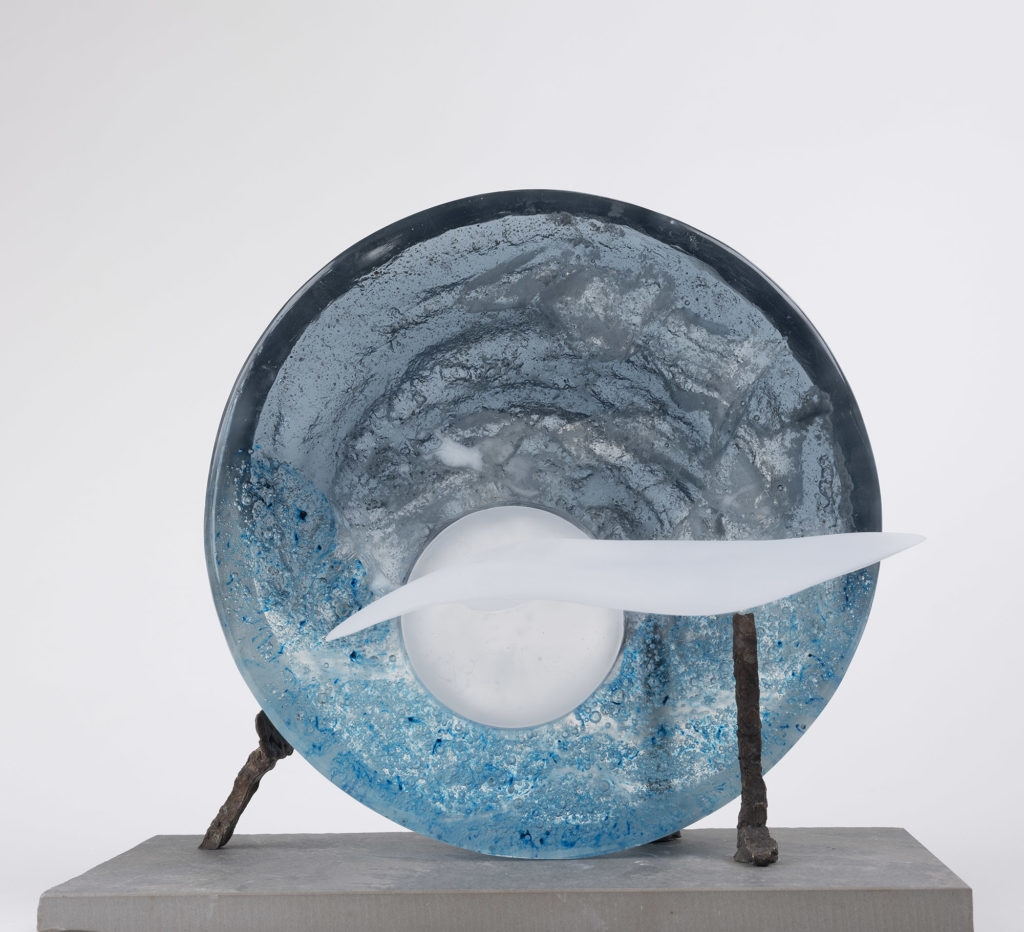
“My goal is to transcend the particular and strive for mutuality. Much of my memory references involve coastal environments of my childhood and it has been a natural progression to consider the nature of the oceans and the environmental threats. Therefore, alongside the sensation of place and history, I also tell the story of the threat to the marine biosphere.
My work exhibits a dynamic element that reflects the natural movement of sea, sand, clouds and plants. I have developed a range of glass-casting techniques that include the layering of precast elements and textural casting. This process of layering images mimics the way our memories are created of layers of experience and retold traditions.”
Artistic responses to Deep Water
Climate change is coming as a result of human bad habits
Increasingly we know that underlying the problems of climate change are human bad habits.
industrialisation,
pollution
over -consumption
All have led to climate change.
In looking at artistic responses to major ocean wildlife and habitat decline, we are looking for rays of hope. Not only do the artists show us the beauty in danger, but that creates in us as the viewer the desire to engage, to be involved, to be concerned. Our increased knowledge will lead to greater engagement – and that will be the beginning of our real impetus to change our habits as consumers – and as humans interacting more knowledgeably and carefully with nature.
We will work together with you, our audience – to strengthen their impact. So join with us to watch and listen.
